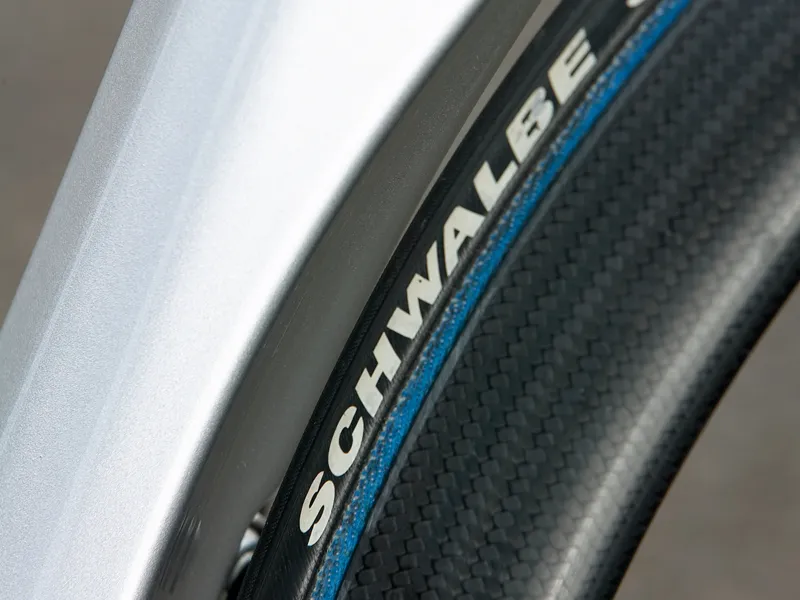Since its early forays into carbon fibre as a frame material around half a decade ago, the German brand Storck has continued to improve its products through a rigorous process of refinement in design, materials and execution.
The ultimate result of this was clearly evident in the Fascenario 0.7 and its amazing sub one kilo frame. Thankfully, other models in the range have benefited from the same process, as can be witnessed in our latest Storck test machine, the Scenario Aero.
Available as both a frameset-only or a complete bike, ours came equipped with a tantalising selection of mouth watering high-end components, seemingly chosen for their obvious low drag factor, their one-of-a-kind appearance, and hopefully all for their performance and function. Our pre-production model lacked anywhere to attach a bottle cage, but the production version is available with two sets of bosses in the standard locations of seat- and down-tube.
Storck is imported into the UK by Poshbikes, which offers just about any combination imaginable when it comes to set up and spec. Therefore, the price of the complete bike can vary substantially depending on your choice of equipment.
Frame: sculpted and slippery
Produced in China in a bespoke facility, in proximity to the Mitsubishi carbon fibre manufacturing plant, Storck has complete freedom in choosing the appropriate weave pattern and fibre combination for the given application in the frame. Using computer stress analysis, they 'fine tune' every square inch of the structure; this is immediately evident upon close inspection. All sides of the head tube zone have been sculpted deliberately to create the smallest frontal area possible.
A one and one-eighth inch conventional integrated headset offers a welcome nod to widespread serviceability. This flows beautifully into a broad shouldered top-tube that tapers gracefully to the seat cluster. Down-tube and seat-tube are deliberately widened into a broader elongated diamond shape to maximise lateral stiffness while still maintaining aerodynamic efficiency. There is enough brawn in the head-tube and bottom-bracket zone to keep things nicely stout.
With low drag coefficient and all around good handling as a prime directive, Storck has graced the front of the bike with its Stiletto Aero fork, weighing a svelte 388g. Elegantly curved blades increase in cross section in the highest load areas, then flow into a gently sloping crown to meet the lower head tube.
Thin stainless steel protective plates over carbon fork tips, and an aluminium sleeve over the carbon steerer in the crown race area ensure durability with minimal weight gain. Mechanics across the land can breathe a sigh of relief: the high anxiety associated with cutting a seat tube that is part of the frame structure has been virtually eliminated through the use of a normal 31.6 by 320 mm seat post. A special teardrop shaped alloy collar acts as both seat post clamp and base onto which the upper 'shroud', once trimmed, is meant to be bonded.
It can then be defined as a 'clamping structure', and thus satisfies UCI rules prohibiting any type of fairing. More applause should be given to the completely rattle-free and hassle-free internal cable routing, achieved through the use of permanent guide tubes for rear brake and derailleur. Finally, a rear triangle with reasonable tube cross-sections gracefully tapers towards rear facing dropouts made of hollow machined aluminium forgings. Tyre clearances are good, allowing up to 25 mm profiles. The two-tone 'Speed Blue over Silver' paint, with a touch of exposed carbon weave under the lettering, harks back to early sixties jet fighters, like Chuck Yeager's polished silver F104 Starfighter, or early Russian MIGs.
Handling: surprisingly versatile
On first approach, in its current 'Obree-esque' incarnation, one could easily be misled into thinking they were about to straddle a pure tester's dream: 100 miles 'on the rivet' in dual-carriageway heaven. It was quickly apparent that a number of position variations were available. I soon found myself sitting back in the saddle, comfortably behind the pedals, easily flicking the bike in nimble changes of direction. Its multi-dimensional qualities became obvious: low drag, quick handling, snappy acceleration.
Storck describes the Aero as a 'three-in-one' bike for road, time trial and triathlon. This it surely is. Classic 73.5 parallel head- and seat-tube angles with 55.3cm plus top-tube for the medium frame, combined with a long saddle, allowed me to get 7 to 9cm or more behind the bottom bracket centre. Perfect for power climbing in the saddle, and grinding out long flat windy stretches of road. Quick bursts of speed and sprint efforts were aided by excellent balance and responsive steering, as there was just the right amount of give in the forks and stays to keep the bike smooth and confident when cornering at speed over rough and unpredictable surfaces.
In full TT stretch, the Tula bars put me at my outer limit of reach and control. Ideally, a conventional drop bar with clip-ons would be more suitable and less alarming, given the nimble front end. Gusty crosswinds had little effect on either wheels or frame due to their aerofoil shape, specifically designed to convert lateral air flow into forward motion. The thin carbon walls throughout the frame structure, combined with the high pressure lightweight tubulars, imparted a tightly tuned drum sensation to the overall feel and sound of the bike: "zing with hum", generating just the right tone at speed. Superb!
Equipment: Awesome hoops! Pick 'n' mix components
Based in the Lone Star State, Nimble produces an array of advanced composite wheels for most cycling purposes. Using low void custom weaves, it achieves a surprising amount of lateral rigidity, given such a narrow cross section. This set of 'Crosswing' three-spoked wheels is imported by Poshbikes, after having been customised on request with superior interchangeable DT/Hugi 240S hubs. Sealed high quality cartridge bearings all round ensure low friction and maintenance. A unique bullet-proof 'clutch-drive' system (opposed ratcheting plates instead of the usual two or three pawl system) gives instant pedal uptake with a distinctive freewheeling sound.
These wheels were incredibly fast and comfortable. Large unbuttressed gaps between the aerofoil-shaped spokes offer a measure of vertical compliance which, when shod with Schwalbe Stelvio 19mm tubulars, provided a dream combo. Even better, put on some Corsa CX's in 23, and use them for the weekly club run and training duties: they're tough enough, and why go slow when you can go fast?
Our test bike came equipped with a mixed bag of unique high-end kit; skeletal M5 brake callipers, supersonic USE Tula bars, Storck's own Power Arm Pro cranks, which are outrageously light at only 315g, insane carbon chainrings by Poshbikes, and a Tune AC38 titanium bottom bracket with ceramic hybrid bearings, which use an occasionally creaky square taper.
Although beautifully executed, the Tula bars didn't provide a low enough position when held by the external 'pods'. As real-world road conditions meant that I was often preparing to use the awkward brake levers or relaunch out of the saddle, too much forward planning was required to ride with confidence. Although braking was powerful, a more flowing shaped set of callipers such as Campagnolos would surely improve the aero theme.
More familiar Campagnolo Record Carbon/Ti derailleurs, bar-end shifters and cassette handled the drive train and shifting duties with a reassuringly solid and precise action: but full-metal internals only, please! A correctly padded and long Fizik Arione Saddle with Ti rails, on top of a traditional seat post made of thin-walled Tange alloy tubing, provided the type of generous comfort that is often in short supply on radical machines.
Summary
With a more sensible drop-bar and clip-on configuration, the Storck comes into its own as a versatile and super-fast ride for anything - from short and hilly triathlons, to 40km dual-carriageway time trials, and even Sunday club runs or long hard road races.
At £5769, if money were no object and only looks mattered, then the Storck as seen here could possibly represent what the inner boy-racer in all of us would love to own, but couldn't because of spending constraints.
However, combining the superb frameset and wheels, priced respectively at £2219 and £1180, with a more budget minded pick 'n' mix of components along the lines of Ultegra or Chorus, would bring the Storck Aero within reach of mere mortals. It would certainly still make it one of the most effective weapons in a weekend-warrior's arsenal.



